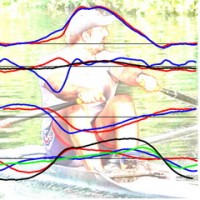Rowing Biomechanics Publications in 2023

A few articles in the area of Rowing Biomechanics were published in 2023, and here are our brief reviews.
Scientists from the Australian Sport Institutes analysed the winning times from the latest World regattas: Olympic Games – 2021 and World Championship - 2022 (1). The purpose was to find performance benchmarks (similar to “Gold Standard times”) that could be used in rowers’ selection, defining training intensities and monitoring progression. It was impossible to achieve this purpose adequately because of the dominating effect of variable weather conditions on rowing speed and subsequently the lack of information on environmental factors during World regattas. Two research directions were proposed to solve this puzzle in a future: 1) Setting a standard for environmental data collection at World regattas; 2) Power measurement and analysis of its relationship to speed.
An article on the border between Biomechanics and Psychology was published by Norwegian scientists (2) from various universities, who studied effects of cognitive load during erg rowing. Two groups of elite and non-elite rowers performed 3 min trials on RP3 erg at 75-85% of race pace with and without solving arithmetical tasks. The findings were: 1) under cognitive load, all “participants reduced movement complexity”; 2) “the rowers' kinematics were affected by cognitive load irrespective of skill level”.
French sport scientists published two studies of technical parameters and rowing performance on the RP3 ergometer using BioRow instrumentation and analysis methods. In the first article (3), they related rowing power with indicators of body segments work (mean and peak powers for legs, trunk and arms), pelvis and trunk spatial orientations (measured with inertial units) and EMG activities of abdominal, core muscles and glutes. The results of the study highlight the importance of trunk power production and core stability for rowing performance.
The second study (4) used the same instrumentation and methods but analysed effects of the stroke rate on rowing technique. It confirmed our previous findings that higher stroke rate induces greater power production during the first half of the drive phase. Also, the stroke rate influenced core stability, so training at higher rates should be more efficient to improve force transfer capacity through the core.
The authors from universities in Iran and Czech Republic (5) used the VICON video analysis system to study knee and hip extension while rowing on a stationary Concept2 ergometer. The results demonstrated the importance of the knee joint in rowing at “sub-maximal” stroke rates (24-28spm) and the shift of movement to the hip at higher rowing stroke rates (28-36spm).
An interesting paper on blade efficiency was published by Dutch hydro-dynamists (6), who used a robotic 1:5 model of a rowing boat with two oars in a rowing tank to determine the performance of rowing blades with different sizes and blade cant angles. The study yielded two outcomes: 1) a 15-deg forward cant angle of the blade, relative to the oar shaft, can positively impact rowing performance; 2) with the same power input, increasing the blade area by 4–6% results in a 0.4% higher speed.
Lastly, I must highlight an outstanding book 'Rowing Science' (7) edited by my colleague and good friend Dr. Volker Nolte. In this book, Volker wrote four chapters, where he assembled his excellent knowledge and vast experience in Rowing Biomechanics. Truly, Volker and his co-authors did a tremendous job with writing and editing this book, which is an excellent practical manual and a “must read” publication for all rowers and coaches.
References
- Binnie MJ, Astridge D, Watts SP, Goods PSR, Rice AJ and Peeling P (2023) Quantifying on-water performance in rowing: A perspective on current challenges and future directions. Front. Sports Act. Living 5:1101654.
- Herrebrøden H., Jensenius A.R., Espeseth T., Bishop L., Vuoskoski J.K., (2023) Cognitive load causes kinematic changes in both elite and non-elite rowers. Human Movement Science 90 (2023) 103113
- Simon F.R., Ertel G.N, Duchene Y., Maciejewski H., Gauchard G.C., Mornieux G. (2023) Prediction of rowing ergometer performance by technical and core stability parameters. Journal of Sports Sciences, DOI: 10.1080/02640414.2023.2219076
- Duchene Y., Frédéric R. Simon F.R., Ertel G.N., Maciejewski H., Gauchard G.C., Guillaume Mornieux G. (2024): The stroke rate influences performance, technique and core stability during rowing ergometer. Sports Biomechanics, DOI: 10.1080/14763141.2024.2301992
- Pakravan F., Abbasi A., Noorinezhad Z., Zdenek Svoboda Z., Tazji M.K., Dastmanesh S. (2023) Effects of rowing stroke rates on lower extremity intra-joint coordination variability in experienced young rowers. PLoS ONE 18(12): e0286999. https://doi.org/10.1371/journal.pone.0286999
- van Nieuwburg WCAM, van Spreuwel BJJ, Tran MTK, Yang MD, Greidanus A, Mulder G, Tummers MJ, Westerweel J, Suijker W and van Wijk R (2023) Improving rowing performance by adjusting oar blade size and angle. Front. Sports Act. Living 5:1109494. doi: 10.3389/fspor.2023.1109494
- Nolte V., ed. (2023) Rowing science. Champaign, IL : Human Kinetics. ISBN 9781492594383
©2024 Dr. Valery Kleshnev



